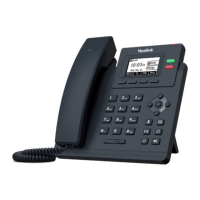
Do you have a question about the Yealink T31G and is the answer not in the manual?
| PoE | Yes |
|---|---|
| VoIP Protocols | SIP v1 (RFC2543), v2 (RFC3261) |
| Number of SIP Accounts | 2 |
| Wall Mountable | Yes |
| Local Phonebook | 1000 entries |
| Lines | 2 |
| HD Voice | Yes |
| Display | 2.3 inch 132x64 pixel graphical LCD |
| Resolution | 132x64 pixels |
| Network | Gigabit Ethernet |
| Audio Codecs | G.711(A/μ), G.722, G.729AB, G.726, iLBC |
| Headset Support | RJ9 Headset Port |
| Standards Compliance | IEEE 802.3af |
| Operating Temperature | 0°C to 40°C |
| Operating Humidity | 10% to 95% (non-condensing) |
Overview of the phone's black and white display screen, indicator LED, and various buttons and keys for task operations.
Details on programmable Line Keys, configurable as speed dials or favorites, located to the right of the display screen.
Explanation of context-sensitive Soft Keys that display options based on call status, such as History, Directory, DND, and Menu.
Information on the dialpad, four-way navigation pad for menu traversal, and volume buttons for audio and ringer adjustments.
Description of six additional buttons below the navigation pad for functions like Mute, Voicemail, Transfer, Headset, Redial, and Speakerphone.
Steps to place a call using the handset: pick up, enter number, press Send softkey.
Steps to place a call using speakerphone: press button, enter number, press Send softkey.
Steps to place a call using a headset: press button, enter number, press Send softkey.
Answer incoming calls by simply picking up the handset.
Answer incoming calls by pressing the Speakerphone button.
Answer incoming calls by pressing the Headset button.
End an active call by replacing the handset on the cradle.
End an active call by pressing the End Call soft key or the speaker/headset button.
Steps to initiate a three-party conference call by connecting additional parties.
Transfer a call directly to another party without prior consultation.
Transfer a call after speaking with the receiving party to confirm acceptance.
Steps to configure call forwarding for unconditional, busy, or no-answer scenarios.
How to disable the phone's microphone to consult privately during a call.
Procedure to assign a phone number to a key for quick dialing.
Instructions for dialing a pre-defined number by pressing a configured speed dial key.
How to access and listen to voice messages indicated by the message waiting indicator or LED.
